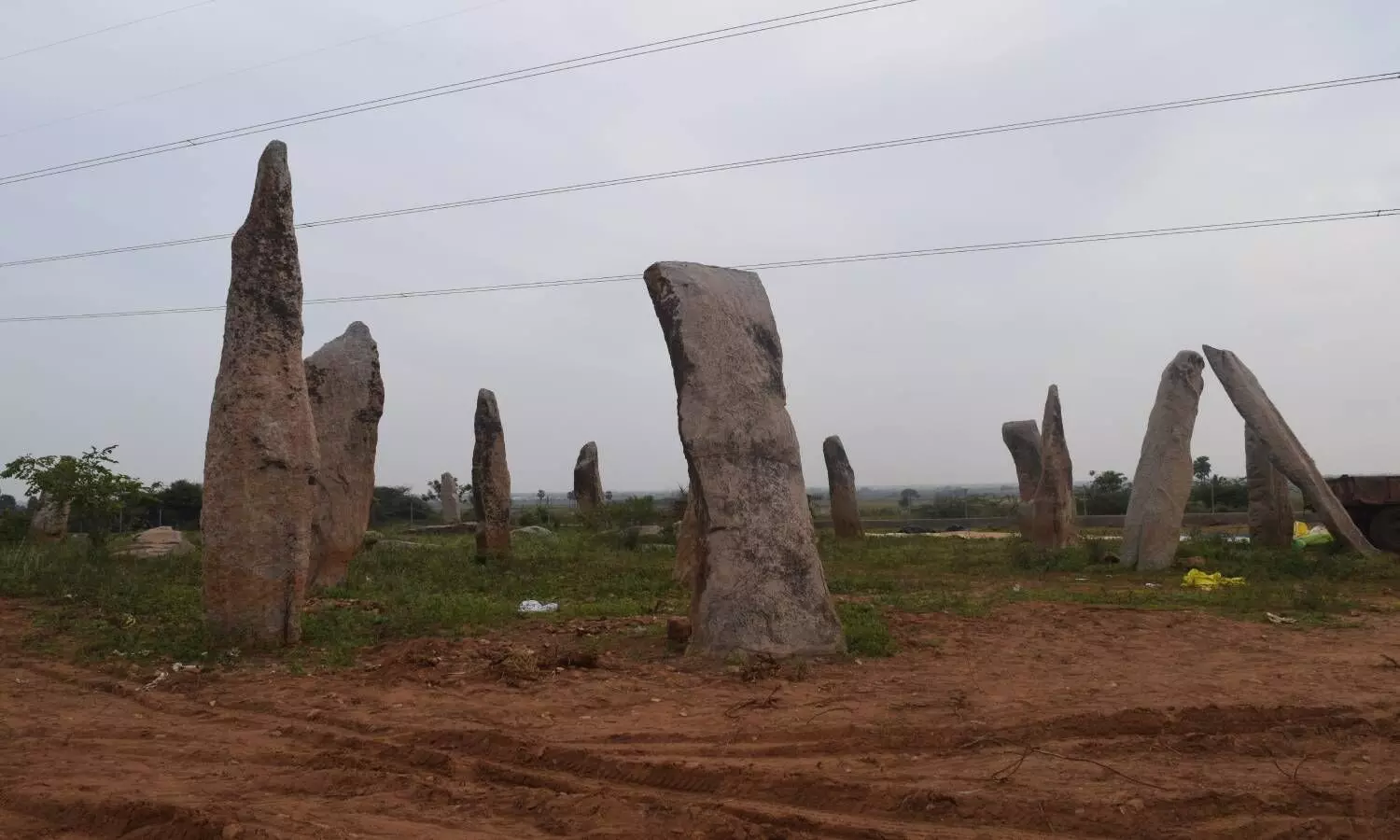`Mudumal Menhirs': An archeological marvel buried in sands of time
A person visiting these 3000-years-old stones, belonging to the megalithic period might for a moment wonder if they are at Stonehenge, the UNESCO World Heritage site in the United Kingdom.
By Nimisha S Pradeep
Big, tall stones with varying inclinations placed randomly stand in grandeur. Their grandeur has reduced over time, with some fallen on the ground, notwithstanding the testing times.
A person visiting these 3000-years-old stones, belonging to the megalithic period might for a moment wonder if they are at Stonehenge, the UNESCO World Heritage site in the United Kingdom. But the presence of this historical treasure in the interiors of Mudumal village in Krishna Mandal in Narayanpet district remains unknown to the outside world.
"My mom used to tell me stories about these stones. Now I tell the same to my children," says Anjappa, a resident of the Mudumal village. But Anjappa hopes to protect the remaining stones at least so that they exist for his future generations.
The menhirs of Mudumal is a historical marvel. It is believed to have been used by the people of the megalithic era for identifying seasons. Spread around five acres of land, the 10 to 14 feet high stones are placed according to the sun's position and provide shadows at different angles during different periods of the year. With the help of the shadows, the people in those days identified the season and decided the suitable crop to be cultivated.
Locals believe that it is sinful to remove stones or rocks from this area. "According to folklore, ages back, a lady had come here begging for food. The people asked her to break all the rocks and come so that they'll give her food. But when she came after completing the task, the villagers refused to give her food. The angry woman cursed the place and said that any person who tries to take stones or rocks from the place will die. So till today, nobody dares to pick anything from here," explains Anjappa.
It's the interior location that is hindering its popularity, notes Chakrapani, Village Revenue Officer of Mudumal village. Recently, with the efforts of the local administration, the State Archeological Department conducted studies and confirmed that it's a place to be preserved.
Previously a private land, the Archeological Department has now taken over this land. Professor K P Rao of the University of Hyderabad has also done extensive research on the menhirs of Mudumal.
Prof. Rao, a former Director of the State Archeological Department, has been researching the menhirs since 2003. Based on his studies, he believes that the menhirs at Mudumal is probably the largest megalithic-era burial site in south India and is as old as 3,500 years. Also, he points out that apart from the archeological relevance, these menhirs are astronomically significant too.
Prof. Rao and his team had observed the menhirs during the summer and winter solstices. Their observations revealed that each row was planned in a certain way so that it gets aligned to the sun at a specific time and date. Using this complex alignment, the people of that era tried to determine the commencement of seasons or worked to prepare a calendar based on the sun's positioning with these monuments.
But still, a lot more is left to be done. From a place that had around 80 such big stones, it now houses only 39 stones, all the others either removed or fallen. With half the stones destroyed, the locals here fear if heavy rain or wind will bring down the rest. They feel that something should be immediately done to preserve the remaining stones.
Traveling around 2kms further ahead on the same road, one finds big, round-shaped rocks placed in circles. "They are called Banthi Rallu or ball-shaped rocks," says Chakrapani.
Just near one of the circles is a rectangular piece of big stone with circular carvings representing the stars in the night sky. Prof. Rao through his studies found this to be similar to the constellations 'Ursa major' and 'Sapta Rishi'.
"Women those days used to stay inside these circles at night believing that insects won't attack them," explains Chakrapani. Using a direction detection app on his mobile phone, Chakrapani marvels at the expertise of the people in the stone age era and points out how the north direction was exactly identified by them.
But right next to one of the circles, you find a big heap of round-shaped rocks piled up. "When more land was required for agriculture recently, people disturbed the arrangement and dumped all the rocks here," says Chakrapani. As a result, the number of Banthi Rallus has also reduced.
Apart from these two marvels, the stones here are also peculiar. They have peculiar shapes carved on them, are lighter, and are found in different colors.
Planning a visit?
Located around 200 km from Hyderabad, the menhirs of Mudumal can be a little tricky to reach if you don't have a private vehicle. But no worries, you can take a bus from MGBS to Makthal and arrange a private vehicle from there to reach Mudumal, around 26 km from Makthal bus station.